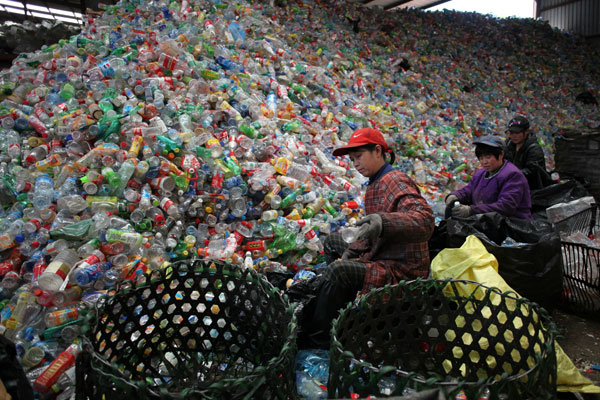Beijing landfills to be brought into line in 2 yrs
Updated: 2013-04-09 23:47
By ZHENG XIN (China Daily)
|
||||||||
Beijing has vowed to regulate 75 unofficial landfills by the end of this year and another 100 next year, while bringing 250 landfills into line by the end of 2015.
The pledge has come from the Beijing Municipal Commission of City Administration and Environment.
 |
|
Workers sort plastic bottles at a waste treatment market in Xiejia village, Beijing, on Monday. WANG JING / CHINA DAILY |
The commission said it will improve leachate capacity at informal landfills. Leachate is any liquid that, in passing through matter, extracts solutes, suspended solids or any other component of the material it has passed through.
"Informal landfills pose a serious environmental threat and health damage to the country if left unregulated," said Mao Da, an expert in solid-waste management at Beijing Normal University.
Mao said the standard of landfills in the capital varies, and some without proper management are posing a serious threat to the environment.
Without a proper landfill procedure, some buried waste will seriously pollute underground water and soil. Some waste even pollutes air quality, Mao said.
Workers at unofficial sites, mostly without standard instructions and guidance, might also damage their health during the landfill process, he said.
The government is also considering excavating waste buried in landfills, sorting and incinerating it starting in 2015, to improve the landfills' sustainability.
However, the commission said the list of landfills involved in the waste incineration plan has not been decided.
Some landfills have been used for more than 20 years and some will be full in two or three years. Burning some of the waste will turn it to ash, providing more space, the commission said.
Liu Shenbo, chief engineer at a waste incineration plant in Gaoantun village in Beijing, said waste excavation will not cause secondary environmental pollution if handled properly.
The Gaoantun incineration plant in Chaoyang district is the biggest garbage incineration plant in the capital.
Mao said some waste in Beijing landfills has been excavated before and no serious pollution was caused.
However, he said a strict environmental evaluation audit is important for waste incineration, to ensure the environment is not damaged in the future. "Pollution caused by incineration plants, without proper procedures, is hard to estimate," he said.
Composting, landfills and incineration are the three major ways garbage is treated in China.
The Lujiashan waste incineration plant, which will become the capital's largest, will undergo a trial operation in September and have a daily processing capacity of 6,000 tons, said the commission.
The plant, in the western outskirts of Mentougou district, once operational, will greatly reduce Beijing's waste disposal burden. Power and heat it generates will be supplied to western areas of the capital, the commission said.
Chen Liwen, a researcher at Nature University, an environmental non-governmental organization, said, "Existing facilities are struggling to meet increased demand. ... Many sites only have capacity for several years."

 Li Na on Time cover, makes influential 100 list
Li Na on Time cover, makes influential 100 list
 FBI releases photos of 2 Boston bombings suspects
FBI releases photos of 2 Boston bombings suspects
 World's wackiest hairstyles
World's wackiest hairstyles
 Sandstorms strike Northwest China
Sandstorms strike Northwest China
 Never-seen photos of Madonna on display
Never-seen photos of Madonna on display
 H7N9 outbreak linked to waterfowl migration
H7N9 outbreak linked to waterfowl migration
 Dozens feared dead in Texas plant blast
Dozens feared dead in Texas plant blast
 Venezuelan court rules out manual votes counting
Venezuelan court rules out manual votes counting
Most Viewed
Editor's Picks

|

|

|

|

|

|
Today's Top News
Boston bombing suspect reported cornered on boat
7.0-magnitude quake hits Sichuan
Cross-talk artist helps to spread the word
'Green' awareness levels drop in Beijing
Palace Museum spruces up
First couple on Time's list of most influential
H7N9 flu transmission studied
Trading channels 'need to broaden'
US Weekly

|

|







